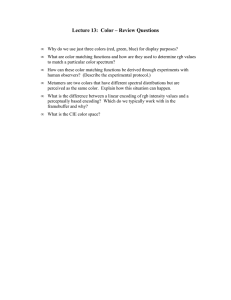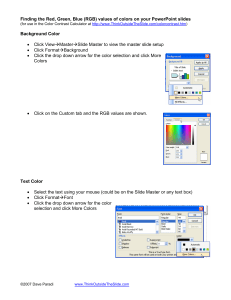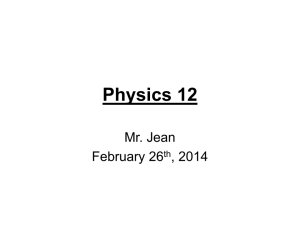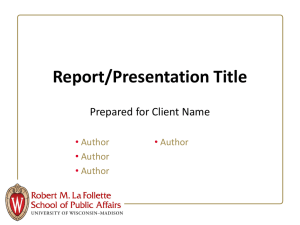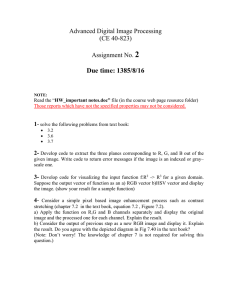Seeking Funding: Week 2 “The Art of the Start” RGB
advertisement
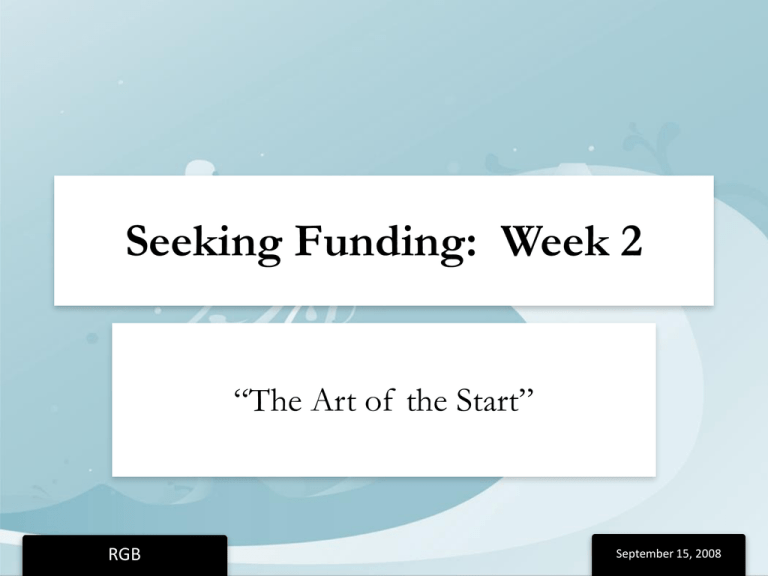
Seeking Funding: Week 2 “The Art of the Start” RGB September 15, 2008 “The Art of the Start” • By Guy Kawasaki – Managing director of Garage Technology Ventures – Previous Apple Fellow – Previous head of Macintosh Division • Talks of the “microscope” and “telescope” phases of business cycles. – Microscopes – level-headed thinking, back to basics, experts magnify every detail. – Telescopes – entrepreneurs bring the future closer, dream up “the next big thing.” RGB September 15, 2008 So – let’s look into our telescopes • “My goal is to help you use your knowledge, love, and determination to create something great without getting bogged down in unnecessary details.” • “My presumption is that your goal is to change the world – not study it.” RGB September 15, 2008 Today . . . • . . . think of yourself as an entrepreneur. • What are you gonna sell? – Your research idea. – Your nonprofit. – Yourself. RGB September 15, 2008 GIST • 1. 2. 3. 4. 5. Great Ideas for Starting Things Make meaning Make mantra Get going Define your business model Weave a MAT (milestones, assumptions, and tasks) RGB September 15, 2008 1 - Make Meaning “Among the meanings of meaning: – Make the world a better place. – Increase the quality of life. – Right a terrible wrong. – Prevent the end of something good.” • Exercise -- Complete this sentence: “If your organization never existed, the world would be worse off because _____________________.” RGB September 15, 2008 2 - Make Mantra • “What kind of meaning do you see your organization making”? • “Close your eyes and think about how you will serve your customers.” • Kawasaki says a mantra is better than a mission statement. • Mission statement generator: http://www.unitedmedia.com/comics/dilbert/g ames/career/bin/ms.cgi RGB September 15, 2008 “A mantra . . . • . . . is a sacred verbal formula repeated in prayer, meditation, or incantation, such as an invocation of a god, a magic spell, or a syllable or portion of scripture containing mystical potentialities.” • Good examples: – Authentic athletic performance (Nike) – Fun family entertainment (Disney) – Rewarding everyday moments (Starbucks) RGB September 15, 2008 Mantras • Don’t confuse mantras with tag lines. • Taglines (e.g., “Just do it”) are for customers; mantras are for employees. • Some hypothetical examples from Kawasaki. • Exercise: Write your organization’s mantra: ___________________. RGB September 15, 2008 3 – Get going • Prototype, build a model, start offering your services, . . . • Key principles for getting going: – Think big. – Find a few soulmates. – Polarize people – you don’t have to please EVERYONE. In seeking funding, it’d be better to be last on ninie lists and 1st on one list than 2nd on 10 lists. – Design different – Use prototypes as market research RGB September 15, 2008 GIST (cont’d.) 1. 2. 3. Make meaning Make mantra Get going 4. Define your business model – this will be our grant/contract application. 5. Weave a MAT (milestones, assumptions, and tasks) RGB September 15, 2008 5 – Weave a MAT • 1. 2. 3. 4. 5. 6. 7. Milestones (Kawasaki suggests 7): Prove your concept Complete design specifications Finish a prototype Raise capital Ship a testable version to customers Ship a final version to customers Achieve breakeven RGB September 15, 2008 Assumptions • Include factors such as: – Product or service performance metrics – Market size – Gross margin – ROI for the customer RGB September 15, 2008 Tasks • All major tasks – necessary to build an organization, though not as critical as the 7 milestones: – Acquire office space – Find key vendors – Set up accounting and payroll systems – File legal documents – Purchase insurance policies RGB September 15, 2008 The Internal Entrepreneur • “Reboot your brain” handout RGB September 15, 2008 Positioning • “It represents the heart and soul of a new organization, stating clearly – Why the founders started the organization – Why customers should patronize it – Why good people should work at it.” • To his list I’d add – Why people should invest in it. RGB September 15, 2008 Positioning: Seize the high ground • Positive. It’s not a war. You don’t want to bury others. What are the benefits of working with YOU? • Customer-centric. Not “the leading company.” Empowering. Why should people want to work for/with you? • Self-explanatory. Save money? Peace of mind? Specific. Who’s the intended audience? • Core. • Relevant. • Long-lasting. • Differentiated. RGB September 15, 2008 Niche Thyself • What specifically do you do? • Make it personal. – Handout from p. 38. • Speak English. – Read two para from p. 39. • Apply “the opposite test” – If you claim something, would your competition claim something different? “High quality”? “Safe.” – If not, then it’s not meaningful. – Offer “concrete proof points” (handout) RGB September 15, 2008 Positioning Exercise RGB September 15, 2008 Positioning Exercise • Pick your project. The one for which you wrote a mantra. • Write a title. • Write a positioning statement. – One page. – Running prose, bullet points, whatever you choose. – Your niche. Personal. English. – Positive. Customer-centric. Empowering. Selfexplanatory. Core. Long-lasing. Differentiated. RGB September 15, 2008 The Art of Pitching • In pitching, “get off to a fast start, explain the relevance of what you do, stay at a high level, listen to audience reaction, and then pitch over and over again until you get it right.” • Explain yourself in the first minute. • The audience is thinking, “What does his/her organization do”? Do ‘em a favor – answer that question in the first minute. RGB September 15, 2008 Pitching (cont’d.) • Establish what you do – make it short and sweet: – We sell software. – We sell hardware. – We teach underprivileged kids. – We prevent child abuse. • “Little Man” story – p. 46. – “For instance” handout. – “I’ve seen it done better.” RGB September 15, 2008 Know your audience • “The foundation of a great pitch is the research you do before the meeting starts.” • “Learn what’s important to your audience.” • Some of the information will be in the call for proposals – there may be other research to be done about things like what the sponsoring agency has funded before. RGB September 15, 2008 10/20/30 rule • • • • 10 slides 20 minutes 30-point-font text Handout – Investor pitch. RGB September 15, 2008 Final Exercise • • • • Write your “elevator pitch.” One minute. By the clock. Be prepared to give it. Ask your audience to write down one sentence that explains what your organization does. • Collect ‘em. Compare. How’d you do? RGB September 15, 2008
